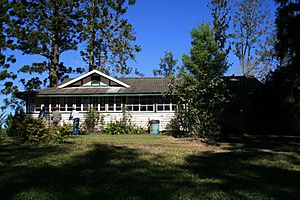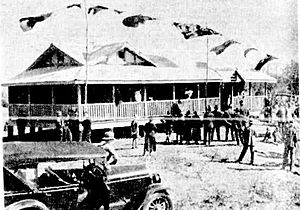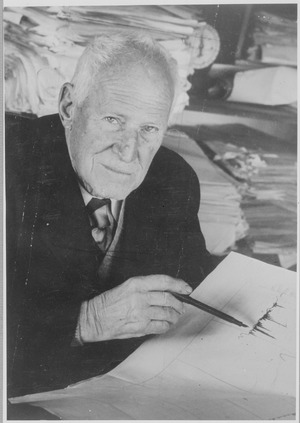Crohamhurst Observatory facts for kids
Quick facts for kids Crohamhurst Observatory |
|
|---|---|

Former Crohamhurst Observatory, 2007
|
|
| Location | 131 Crohamhurst Road, Crohamhurst, Sunshine Coast Region, Queensland, Australia |
| Design period | 1919 - 1930s (interwar period) |
| Built | 1935 |
| Official name: Crohamhurst Observatory (former), SEQ-1F 4 | |
| Type | state heritage (built) |
| Designated | 13 November 2008 |
| Reference no. | 602682 |
| Significant period | 1935-1990s |
| Lua error in Module:Location_map at line 420: attempt to index field 'wikibase' (a nil value). | |
The Crohamhurst Observatory is a special heritage-listed building in Crohamhurst, Queensland, Australia. It was built in 1935. This observatory is important because it was used for a unique type of weather forecasting. It was added to the Queensland Heritage Register in 2008, which means it's protected for its historical value.
Contents
The Story of Crohamhurst Observatory
The Crohamhurst Observatory was built in 1935. It was located on the property of a man named Inigo Owen Jones, near Peachester. Jones used this observatory to study the sun and planets. He also took weather measurements. All of this helped him create his famous long-range weather forecasts.
This observatory shows how people in Queensland used to predict the weather. It's also a rare example of a place built just for long-range weather forecasting. Inigo Jones was very well-known across Australia for his forecasts from the 1920s until he passed away in 1954. The observatory is strongly connected to his life and work.
Early Weather Forecasting in Australia
People in Australia started observing and recording weather when the first European settlers arrived. By the late 1800s, weather science was seen as very important. Most colonies, including Queensland, had their own weather services. They made daily weather maps and forecasts.
After Australia became a country (Federation), the Commonwealth Government took over weather services in 1906. For many years, the official weather bureau focused on short-term forecasts. They also kept detailed records of Australian weather. Later, in the 1990s, Australian scientists became experts at predicting weather for whole seasons. This was very helpful for farmers.
Predicting Weather for the Future
People have been interested in predicting long-term weather for a long time. This interest grew in the mid-1800s, around the same time daily weather forecasting became a science. Scientists noticed that dark spots on the sun, called sunspots, appeared and disappeared in a regular cycle, about every 11 years. They wondered if this sunspot cycle could cause regular changes in Earth's climate.
Many scientists and even enthusiastic amateurs tried to find these climate patterns. They believed that if they could find these cycles, they might be able to predict weather months or even years ahead.
Inigo Jones and His Forecasts
Inigo Owen Jones was born in England in 1872. His family moved to Brisbane, Australia, in 1874. He went to Brisbane Grammar School. In 1888, he started working at the Queensland Meteorological Bureau. There, he learned how to take weather readings from Clement Lindley Wragge, a famous meteorologist.
In 1892, Jones's family moved to a property near Peachester. They named it Crohamhurst. Even though he worked on the farm, Inigo Jones kept recording the weather every day. He became famous on February 2, 1893, when he recorded the highest daily rainfall in Australia at Crohamhurst. It was an amazing 35.71 inches (907 mm) (about 90.7 cm) of rain!
Jones knew that farmers needed good long-range weather predictions. So, he continued the work of his mentor, Clement Wragge. From 1923 onwards, Jones started giving his own long-range weather forecasts. These forecasts were based on his studies of planets and repeating weather cycles. He became very famous for them.
His forecasts were first published in the Brisbane newspaper, the Daily Mail. Later, he wrote articles for other newspapers and farming magazines. In 1927, he moved to Brisbane. He lived there until 1935, when he moved back to Crohamhurst.
Support for Inigo Jones's Work
In the late 1920s, Inigo Jones's work started getting a lot of support. In 1928, the Queensland Government made him the director of a special weather forecasting bureau. A group called the Inigo Jones Seasonal Weather Forecasting Trust was also formed. This group raised money to help Jones with his research. They also convinced the Queensland government to give him money every year.
Even though some official studies said his methods weren't scientific, people still wanted his forecasts. Farmers and other rural groups especially supported him. They even helped pay for his observatory so he could continue his work. Jones was also a member of many important astronomy and meteorology groups around the world.
The Observatory Building
The Crohamhurst Observatory building was paid for by the Seasonal Weather Forecasting Trust and a sugar company. It was officially opened on August 13, 1935, by the Queensland Governor, Sir Leslie Orme Wilson. The Queensland government also helped with the running costs.
The observatory was built on a small hill. Jones designed it to be comfortable in different weather. It had walls and a roof made of fibro-cement. It was open to the north and east for light and air. The south and west sides had double walls to keep out cold and hot winds. There were verandahs on the east and north sides. Inside, it had a large room for calculations and a laboratory.
Around the observatory, Jones had special deep holes in the ground. These were lined with clay pipes. He took temperature readings from different depths, up to 10.67 metres (35.0 ft) (about 35 feet) below the surface. He also took temperature readings from a nearby creek. A special wooden box called a Stevenson screen held instruments like thermometers and barometers. He also used three telescopes to observe the sun.
The main goal of the observatory was to take daily observations of the sun and all weather conditions. This helped Jones test his ideas about how the sun controls weather. He used this information to make forecasts for newspapers and other publications that supported his work.
After Inigo Jones
As Inigo Jones got older, he thought about what would happen to his property and work after he was gone. He offered some of his land to the Department of Forestry in 1946. He had already planted experimental trees there, like hoop pines. This land was given to the government in 1947.
In 1950, he offered more land, including where his house and garden were. This land would be a reserve for forestry after he and his wife passed away. This offer was accepted.
Inigo Jones passed away on November 14, 1954. After his wife Marion died in 1960, the land became part of the "Crohamhurst Forest."
Jones wanted his work to continue. So, a house was built near the observatory in 1951 for his assistant. In 1953, he hired (Robert) Lennox Walker. Walker continued Jones's work after he died.
In 1993, Lennox Walker bought the land, including the historic Crohamhurst Observatory. The building is no longer used for long-range weather forecasting.
Inigo Jones's work was remembered long after his death. In 1982, a plaque was placed at the Crohamhurst Observatory to honor him. It's located where he used to observe the stars.
Some parts of the observatory have changed over time. An extension was added, and the northern verandah was enclosed. The equipment and charts Jones used have been moved. However, the deep earth temperature pits and the Stevenson screen are still there. The building is no longer an active observatory.
What the Observatory Looks Like Today
The Crohamhurst Observatory is located on the southern side of Crohamhurst Road. It's next to the Crohamhurst State Forest. The observatory sits on top of a small, rounded hill. It's surrounded by neat, open grass and tall hoop pine trees.
The site includes the observatory building, built in 1935, and several weather measuring devices in the ground. A gravel driveway leads from the main road to the building.
The observatory building is a single-story structure made of timber. It sits on low timber stumps. It's shaped like a rectangle. The verandahs on the north and east sides have been closed in with weatherboard and windows. The roof is sloped and covered with corrugated fibre-cement sheets. It has small vents at the top. The outside walls are covered with weatherboard. A shed-like addition has been built onto the south-west corner.
Inside, the walls and ceilings are lined with fibre-cement sheets. The floors have linoleum. Some half-height walls and counters open onto the enclosed verandahs.
You can still see several weather devices around the site. To the north-east of the building is a Stevenson screen. This is a small wooden box with vents, set on a steel frame about 1.2 metres (3 ft 11 in) (about 4 feet) high. It protected instruments from direct sunlight, wind, and rain. North of the Stevenson screen are the remains of other devices, like concrete strips with pipes cut off at ground level.
To the east of the observatory building are the deep earth temperature pits. These are clay pipes with metal caps that stick out of the ground about 300 millimetres (12 in) (about 1 foot). A memorial plaque from 1952 is also to the east. It marks where a telescope used to be, but the telescope is gone now. There's also a concrete sundial stand to the west of the Stevenson screen.
A grassy path leads along the treed fence line to Crohamhurst Creek. A line of mature hoop pines grows along the northern fence. The entrance to the property has a small Stevenson screen used as a letterbox.
Why Crohamhurst Observatory is Important
The former Crohamhurst Observatory was listed on the Queensland Heritage Register in 2008 for several reasons:
- Showing Queensland's History: The observatory, with its building and old weather equipment from the 1930s, helps us understand how weather forecasting developed in Queensland. It's where nationally recognized long-range weather forecasts were made and shared across Australia. It shows us early methods used for this.
- A Rare Part of History: The Crohamhurst Observatory is special because it's the only known long-range weather forecasting observatory in Queensland. Its unique building and outdoor equipment, like the deep earth temperature pits and Stevenson screen, are rare examples of how long-range weather forecasting was done in the past.
- Connected to an Important Person: The observatory has a strong link to the life and work of Inigo Jones. He was a very well-known long-range weather forecaster throughout Queensland and Australia from the 1920s until he died in 1954.
Images for kids





